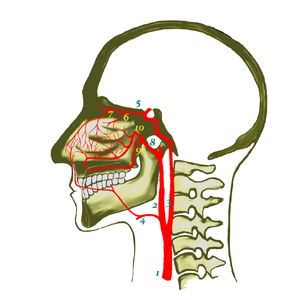Epistaxis
Epistaxis (epi stazein = to drip) is a transient bleeding from broken blood vessels in the area of the nasal mucosa [1]. Most often from the locus Kiesselbachi – cavernous plexus on the septum at the level of the front edge of the lower shell. In some cases, epistaxis is an emergency condition in the ENT.
Etiology[edit | edit source]
It belongs to common occurrences, arising from local and global causes. Provocative moments: blowing your nose, sneezing, bending forward, washing in hot water.
- Local causes
- Most often "trauma" of the face, especially fractures of the nasal skeleton, possibly the septum. Bleeding is usually from the Kiesselbachi locus and is easily stopped. Alternatively, these are frontobasal and maxillofacial fractures. In this case, it is bleeding from a. sphenopalatine or aa. ethmoidales, and this already requires tamponade of the nose.
- Acute or chronic rhinosinusitis, or granulomatous inflammations (TBC, syphilis, sarcoidosis).
- Tumors: hemorrhagic polyp of the septum, angiofibroma of the nasopharynx; carcinoma, malignant melanoma, lymphoma.
- Severe attacks of coughing (with pertussis or pseudocroup); hard snoring.
- Mechanical cleaning of the nose, foreign bodies.
- Nasal application drug
- Adenoid vegetation.
- Common causes
- Angiopathy;
- Coagulopathy: hemophilia, thrombocytopenia (primary idiopathic, secondary to chemotherapy, leukemia), anticoagulation therapy with warfarin, antiaggregant therapy acylpyrine;
- Hypertension (Depending on the change in blood pressure, it stops over time and periodically returns. It is common in elderly patients. Properly conducted antihypertensive therapy is necessary);
- Hereditary hemorrhagic telangiectasia (Rendu-Osler-Weber disease);
- Hepatic and renal failure;
- DIC;
- Febrile infections.
- epistaxis can also occur with hypovitaminosis vit. C and in gestosis in pregnancy.
Diagnostics[edit | edit source]
- Anamnesis-
- duration and intensity, if it is a first attack;
- use of NSA;
- use of warfarin;
- hypertension;
- recent upper respiratory infection
- liver disease;
- blood disease;
- nose injury;
- nose surgery;
- pressure measurement, pulse;
- endoscopy of the nose, anterior rhinoscopy;
- examination blood count (platelets), INR (Quick), APTT; leukocytosis often occurs; with more massive bleeding accompanied by posthemorrhagic hypotension, the urea level may be elevated
- examination by an internist, hematologist.
Treatment[edit | edit source]
In severe or ongoing epistaxis, the priority is to stop the bleeding and locate the source. Further investigation of the causes later in the second period.
- First aid
- Insert tampons into the holes and let the affected person press hard on the wings of the nose.
- We do not tilt the head so that the blood does not flow into the neck.
- Anterior nasal tamponade
- If the situation allows it, after removing the coagulum, we anemize and anesthetize the mucous membrane of the nose.
- Tamponade is performed with a mule strip dipped in "Ophthalmo-azulen" or "Ophthalmo-framykoin".
- We fold it in layers from the bottom to the ceiling of the nasal cavity.
- Finally, we attach a sling bandage.
- A well-done tamponade will almost always stop the bleeding.
- We can leave up to 2 days.
- Front greasy tamponade - strips impregnated with antibiotic ointment, petroleum jelly.
- Anterior absorbable tamponade - Gelaspon®, Spongostan®.
- Posterior nasal tamponade;
- We use an individual sized bulky rigid mule tampon.
- We insert the catheter into the nostril on the affected side, pass through the nasal cavity, through the choanae and bring the end of the catheter out of the mouth.
- We tie the tampon with a stitch and pull it back (so the tampons will be in the nasopharynx).
- We supplement with frontal nasal tamponade.
- Leave the tamponade for 48 hours. (If we leave longer, it is necessary to ensure ATB).
- We check blood pressure and blood count.
- Balloon tamponade
- Made in several sizes, loading is easy. It is channeled (allows breathing through the nose).
- Embolization or ligation a. maxillaris.
- It is performed quite exceptionally.
Electrocoagulation of a vessel with tweezers - bipolar/monopolar.
Chemocauterization - cauterization of small blood vessels with a solution of AgNO3.
![]() After the bleeding has stopped, it is necessary to search for the cause of the epistaxis!
After the bleeding has stopped, it is necessary to search for the cause of the epistaxis!
Links[edit | edit source]
Related articles[edit | edit source]
References[edit | edit source]
- ↑ MUNTAU, Ania Carolina. Pediatrie. 4. edition. 2009. pp. 325. ISBN 978-80-247-2525-3.
Source[edit | edit source]
- ŠTEFÁNEK, Jiří. Medicína, nemoci, studium na 1. LF UK [online]. [cit. 2011-01-08]. <http://www.stefajir.cz/>.
- HYBÁŠEK, Ivan – VOKURKA, Jan. Otorinolaryngologie. 2. edition. 2006. ISBN 80-246-1019-1.


